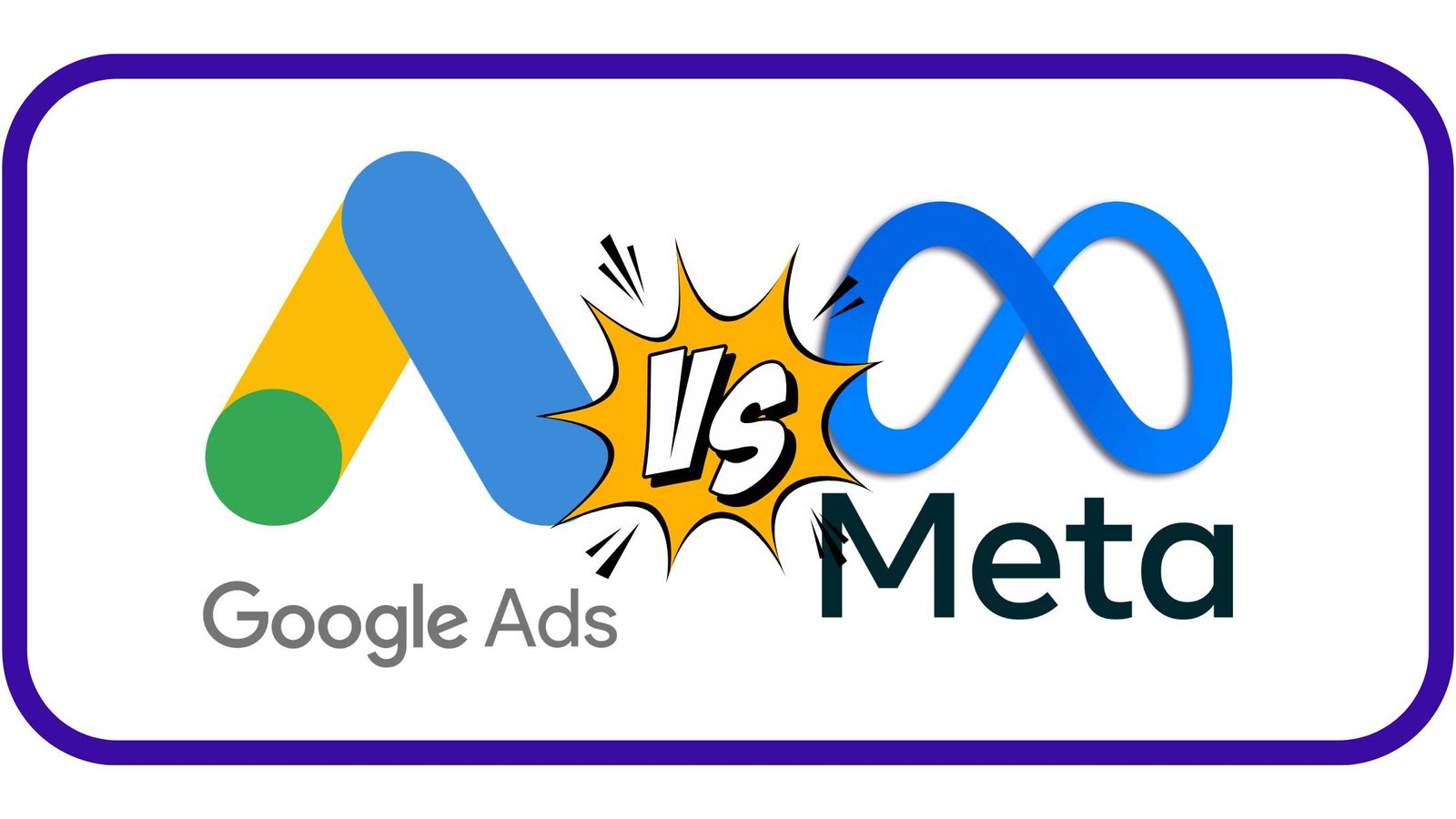Google Ads Vs Meta Ads, When it comes to digital advertising, these two giants dominate the landscape. Both platforms offer powerful tools for businesses to generate leads, increase conversions, and drive revenue. However, their targeting methods, ad formats, and user intent differ significantly.
So, which platform is better for your business? In this article, we’ll break down the five key differences between Google Ads and Meta Ads to help you decide where to invest your advertising budget.
1. Audience Targeting: Search Intent vs. Interest-Based Ads
One of the most significant differences between Google Ads Vs Meta Ads is how they target users.
Google Ads: Search Intent Targeting
- Google Ads primarily use keyword-based targeting through Search campaigns.
- Users actively search for specific products or services, meaning they already have buying intent.
- Advertisers bid on keywords to display their ads at the top of Google Search results, ensuring visibility to high-intent users.
- Google also offers display and video ads that target users based on online behavior and interests, but search ads remain the primary strength.
Meta Ads: Interest & Behavior-Based Targeting
- Meta Ads, including Facebook and Instagram ads, target users based on demographics, interests, and behaviors.
- Instead of users searching for a product, Meta Ads appear in users’ feeds, stories, and reels, interrupting their browsing experience.
- Advanced lookalike audiences and retargeting allow businesses to reach potential customers who resemble their existing clients.
🏆 Winner: If your goal is to capture high-intent buyers, Google Ads is the better choice. If you want to increase brand awareness and nurture potential customers, Meta Ads shine.
2. Ad Formats: Text vs. Visual Content
The success of your ad campaign also depends on the format that best aligns with your brand’s messaging.
Google Ads: Text & Display Ads
- Search Ads: Text-based ads that appear on Google Search results.
- Display Ads: Image-based ads that show up on websites, YouTube, and Gmail.
- YouTube Ads: Video ads placed before or during YouTube videos.
- Shopping Ads: Product-based ads featuring images, descriptions, and prices.
Meta Ads: Visual & Interactive Ads
- Image Ads: Single image-based ads shown on Facebook and Instagram feeds.
- Video Ads: Short video clips that play on stories, reels, and in-feed.
- Carousel Ads: Multiple images in a swipeable format, ideal for eCommerce.
- Story Ads: Full-screen, immersive ads in Facebook and Instagram Stories.
- Collection Ads: Mobile-optimized ads allowing users to browse multiple products in a single ad.
🏆 Winner: If you rely on engaging visual content, Meta Ads provide a more immersive experience. If text-based ads and product searches drive your business, Google Ads might be the better option.
3. Cost & Return on Investment (ROI)
Your budget and expected return on investment (ROI) are crucial factors when choosing between Google Ads Vs Meta Ads.
Google Ads: Higher CPC but High-Intent Traffic
- Google Ads operate on a cost-per-click (CPC) model, meaning advertisers pay each time someone clicks on an ad.
- The average CPC varies by industry but can be expensive, ranging from $1 to $10+ per click depending on keyword competition.
- Since Google targets users with immediate intent, conversion rates tend to be higher, offering a strong ROI for businesses with high-ticket products.
Meta Ads: Lower CPC but Awareness-Driven
- Meta Ads generally have a lower cost-per-click (CPC) compared to Google Ads, with an average CPC of $0.50 to $2.00.
- However, conversions might be lower because users are not actively searching for a product or service.
- Meta Ads work best for top-of-funnel marketing, where businesses nurture potential customers before converting them.
🏆 Winner: If you have a high-ticket product or need immediate conversions, Google Ads provide better ROI. If you’re focused on brand awareness and retargeting, Meta Ads offer a cost-effective solution.
4. Conversion Rate & Buyer Intent
Google Ads: Higher Conversion Rate Due to Buyer Intent
- Users clicking on Google Search Ads already have a strong intention to buy or take action.
- Higher conversion rates (typically 2-5% depending on the industry).
- Best suited for eCommerce, lead generation, and service-based businesses.
Meta Ads: Lower Conversion Rate but Better for Retargeting
- Users discover products or services while scrolling, meaning lower intent to purchase immediately.
- Average conversion rates for Meta Ads are around 1-3%.
- Ideal for building a brand, growing an audience, and remarketing to past visitors.
🏆 Winner: Google Ads generally have higher conversion rates, but Meta Ads excel in retargeting and long-term brand engagement.
5. Best Use Cases for Each Platform
| Feature | Google Ads | Meta Ads |
|---|---|---|
| Buyer Intent | High | Medium |
| CPC (Cost-per-click) | Higher | Lower |
| Best For | Immediate conversions, eCommerce, service businesses | Brand awareness, engagement, social commerce |
| Ad Formats | Text, Search, Display, Shopping | Visual, Story, Video, Carousel |
| Conversion Rate | 2-5% | 1-3% |
When to Use Google Ads:
✔️ If you sell high-ticket items or services with immediate demand.
✔️ If your audience is actively searching for solutions.
✔️ If you have a higher budget and want high-intent traffic.
When to Use Meta Ads:
✔️ If you want to increase brand awareness and engagement.
✔️ If your product/service benefits from visual storytelling.
✔️ If you’re targeting a broad audience for retargeting campaigns.
Conclusion: Which One Should You Choose?
There is no one-size-fits-all answer to whether Google Ads or Meta Ads is better. It depends on your business goals, budget, and target audience.
- For high-intent searches and immediate conversions, Google Ads is ideal.
- For brand awareness, social commerce, and retargeting, Meta Ads is the better choice.
💡 Want expert help in setting up high-converting ad campaigns? At CrescoGMS, we specialize in Google Ads and Meta Ads strategies that drive real results. Contact us today to get the best ad strategy for your business!


